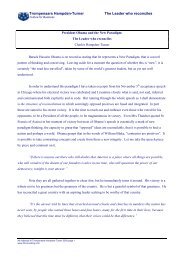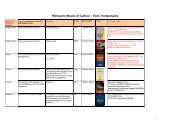Realizing Change Through Other Ways Of Working - Trompenaars ...
Realizing Change Through Other Ways Of Working - Trompenaars ...
Realizing Change Through Other Ways Of Working - Trompenaars ...
- No tags were found...
You also want an ePaper? Increase the reach of your titles
YUMPU automatically turns print PDFs into web optimized ePapers that Google loves.
facing in business. So a person-based culture isoften the result of a leader that strives for a corevalue of entrepreneurship and innovation whilehaving an envisioned future of becoming the mostpathbreaking organization in the field of crossculturalmanagement thinking and consulting. A task/goal driven culture is a much better suited context forleaders that want to help clients gain the highest returnon their investments in the financial service sectorholding a core value of integrity and transparency.But business environments and challengesare changing continuously. Once an organizationalculture has established itself, it creates newdilemmas (or its changing environment will) on ahigher level. For example, a dominant person-basedculture can create a business environment wheremany innovative ideas are born but where themanagement and commercialization of these begson aspects of a more market sensitive task/goaldrivenculture. Conversely, a dominant task/goaldrivenculture can lead to an environment whereemployees are so much guided by their market pricethat it needs a power-based (family) culture to createa necessary longer term vision and commitment.By asking leaders of organizations to phrasethe major tensions they feel as “on the one hand…onthe other” we linguistically program them to see bothsides of the equation (<strong>Trompenaars</strong> & Hampden-Turner, 2002). In order to facilitate this balance inthe approach as well as the link to business, we use anumber of pro-formas to elicit the basic descriptionof their current and ideal organizational cultureprofiles, components they want to retain and discard,as in the following basic framework seen in Figure 3:Figure 3. Sample Pro-forma to Elicit Basic Descriptions ofCurrent and Ideal Organizational Culture Profile.We ensure that the various lists comprisethose that are most crucial to reconcile in viewof the envisioned future. We make sure that theformulation of the horns of the dilemma areboth desirable and are linked to business issues.Examples are: “on the one hand we need to focuson reliable technology (typical for a dominant rolebased culture), whilst on the other we need to beconstantly informed by our main customers (typicalfor dominant task/goal based culture)” or “On theone hand we need to constantly mentor and coachour young graduates for constant learning (person-based culture) whilst on the other hand we need tofocus on the income of this quarter (task/goal- basedculture)”, or “on the one hand we need to developand sustain a loyal workforce and thrive on rapport(power/family-based culture), whilst on the otherhand we need to be able to judge their performancebased on report (task/goal-based culture).”Reconciling the change tensionsSpace limitations will not allow us to go intoall the detailed steps of the reconciliation processbut we show the basic template (see Figure 4) weare using to graphically represent the dilemma:Woolliams and <strong>Trompenaars</strong> 12




